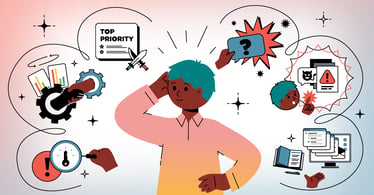How Can Assessments Make Conflict Productive in the Workplace?
Conflict in the workplace can be inevitable, but it doesn't have to negatively impact your overall work culture. In fact, when addressed with diplomacy, conflict can lead to conversation and expanded perspectives.
One of the best ways to handle conflict is to use the right tools. Assessments are one of the best tools available to your organization; they can help develop employees, ensure job-role accuracy, and create a diverse and welcoming workplace.
Let's look at some common causes of conflict in the workplace and find out how assessments can help resolve difficult situations.
The Conflict: Different Expectations For Different Team Members
Each person has their own unique contribution on their team and that should be acknowledged through their job titles.
If you have multiple team members sharing the same title but performing different duties, conflict will likely arise due to confusion and the possibility of different treatment, like a difference in pay.
When expectations for each team member are unclear, the workload of the group can seem off balance. If an employee is doing more work than their coworker with the same title and pay, they're going to feel disengaged and unmotivated. Can you blame them?
The Solution: Get Clarity From Titles
As your team expands, it makes sense to take another look at the titles and job descriptions of your direct reports. Make sure that they correlate with the work they are doing.
Titles that better fit the role, as well as clarity on each individual's job responsibilities, will help to eliminate confusion and areas of potential conflict.
To check for job fit, consider performing a job benchmark. Not just for the hiring process, this assessment matches an individual's assessment results against an idealized conception of their job role, looking for similarities and differences between the two.
Make sure this isn't used as a punishment! Benchmarks are supposed to only be helpful, and can pinpoint discrepancies that make someone's job harder.
You can then either shift the role to better suit the individual or find them a new role to develop into that supports their behavioral style and their needs.
The Conflict: Contrasting Behavioral Styles
Limited experience in understanding different behavioral styles may create misunderstandings and conflict on your team. One person who is naturally very Reflective may feel irked by the way someone who is naturally Direct addresses an issue, and vice-versa.
If you don't understand the reasons behind how someone behaves, it can be a source of strife as you work together.
The Solution: Utilize DISC Language
If your team has all taken the TTI SI DISC assessment, you have created a foundation of understanding in your organization. Using a shared DISC language frequently will keep everyone on the same page and bring clarity to individual behaviors and actions.
Another tool that is commonly used to gain the perspective of two team member's behavioral styles is TTI SI's Comparison Report.
In this report, you can find a checklist for communication that has itemized ways to communicate with each person, as well as how not to communicate with them. This can make conversations and conflict go as smoothly as possible.
The Conflict: Opposite Driving Forces
If motivation isn't aligned on a team, it can be hard to understand why your teammates are acting in particular ways.
If your drivers are clouding your judgment or affecting your actions towards others, conflict is likely to follow, especially when your scores are more in the "Extreme" area of the mean.
The Solution: Increase Awareness of Motivation
Becoming more aware of each of the 12 Driving Forces and how they may present in real life scenarios can help to grow your team's understanding and tolerance. Have conversations with your team and encourage differing perspectives.
Find ways to address those perspectives and help your team understand each other more clearly. Team reports or group wheels are helpful tools that you can use to bring clarity to these conversations.
The Conflict: Low EQ
The most intelligent person in the world may still find it difficult to read the room or interact with others. Knowing how your words or actions can affect the atmosphere for others is crucial, and if you aren't focusing on EQ, conflict can arise.
Low EQ in any of the quadrants can seriously impact the ability to resolve problems in a way that does not create more issues for others.
The Solution: Focus On EQ As A Team
Using the TTI SI Emotional Quotient Talent Report with your team can help give you an understanding of each person's strengths and weaknesses.
Even members who already have high EQ scores can benefit from an understanding of how they score in each of the quadrants, and just starting the conversation by taking the assessment can help people become more open with each other.
Let Assessments Help Make Conflict Productive
Conflict is inevitable but it doesn't always have to be a negative thing!
By harnessing the power of assessments, you can provide a clear path out of conflict for your team and make sure that their experiences in the workplace are more positive than negative.
If you want to take an assessment or get assessments for your team, contact us here.
If you want to join the TTI SI network and become a reseller, learn more.

Hannah Reyes
Hannah helps TTI Success Insights maintain structure, and ensures projects are communicated and delivered on time. She is passionate about helping people and loves to share her expertise on how assessments can positively impact people.




/Dont%20Judge%20a%20Book%20by%20its%20Cover.png?width=374&name=Dont%20Judge%20a%20Book%20by%20its%20Cover.png)
0 Comments